Singapore’s National Souvenir: The Gold-plated Past of RISIS
Much more than a tourist souvenir, Singapore’s gold-plated RISIS orchids were a triumph of grit and branding.
By Sharad Pandian
In December 1982, Diana, Princess of Wales attended the glitzy London premiere of Richard Attenborough’s film Gandhi. To mark the occasion, Singapore gifted her with its signature product – orchids. Specifically, she was sent 5,000 orchid stems and a brooch with a gold-plated orchid.1 This gold-plated trinket was the RISIS (rhymes with “crisis”) orchid that was wildly popular in the 1970s and 1980s, to the extent that it had a serious claim to being Singapore’s national souvenir.
An Identity for Singapore
 An illustration depicting Singapore’s hunt for a souvenir that would be the local equivalent of Malaysian pewterware and New Zealand’s Paua shell. Image reproduced from The RISIS Orchid (Singapore: Times Books International, 1984), 11. (From National Library, Singapore, call no. RSING 739.27095957 JOF).
An illustration depicting Singapore’s hunt for a souvenir that would be the local equivalent of Malaysian pewterware and New Zealand’s Paua shell. Image reproduced from The RISIS Orchid (Singapore: Times Books International, 1984), 11. (From National Library, Singapore, call no. RSING 739.27095957 JOF).To understand the origin of the RISIS orchid, we need to look to the intersection of historical necessity and individual idiosyncrasy. Finding a national souvenir was a problem for Singapore even before its independence. Conscious of the importance of tourism for the economy, the government established the Singapore Tourist Promotion Board (STPB; now Singapore Tourism Board) in 1963.2 One of the committees created at its very first meeting was the Souvenirs Committee.3 After all, “[e]very traveller wants something to bring home as proof and reminder of the place he visited,” informed the Straits Times in 1964. The committee was therefore tasked with “finding a suitable emblem and the types of souvenirs that [could] be produced locally which [would] not only be a keepsake but a constant reminder of Singapore”.4
By the early 1970s, tourism had emerged as a leading sector of economic growth in Singapore. In 1970, 113,000 more people visited the country compared to the previous year, swelling the number of total visitors to 521,650. Income from tourism correspondingly increased by 21.3 percent to $273 million, accounting for nearly 5 percent of the national GDP.5
However, Singapore had not yet settled on an appropriate national souvenir. In 1970, Koh Book Piang, an expert on handicrafts, estimated that while tourists in Singapore had spent as much as $5 million on souvenirs annually, only 1 percent of this was going towards Singapore-made souvenirs.6 The problem, Koh suggested, was that while an item like the boomerang was readily associated with Australia, there was no equivalent for Singapore. He mused, “What item can I mention so that you can associate with Singapore? I would say practically nil.”7
Concurrently, the Straits Times grimly reported in 1970 that “[i]t is officially recognised that a ‘Singapore image’ must be found fast – to inject purpose, prestige and profit into the cottage souvenir industry”.8 Ideas mooted by tourists surveyed included small statues of Stamford Raffles, busts of then Prime Minister Lee Kuan Yew, figurines depicting the four major races, and even a Singapore-shaped music box that played the national anthem. The STPB’s Souvenirs Committee had recommended the Merlion as early as 1964, but it had not won universal acclaim. One government official, for example, was doubtful that it would gain national prestige since “[t]he merlion is symbolic of our name and marine status, but not of our people”.9
Enter Dr Lee Kum Tatt who had been appointed chairman of the Singapore Institute of Standards and Industrial Research (SISIR) in 1969. By his own account, his interest in souvenirs began in 1955 when his fiancée – later his wife – made a passing remark at the Singapore Botanic Gardens wishing that the orchids they were admiring could last forever.10 He began working on this idea in earnest after a trade mission to Eastern Europe in 1967. Noticing that his European hosts were delighted by the orchids he had given them, Lee decided to experiment with preserving orchids in gold, based on nothing more than a gut feeling that it would be popular.
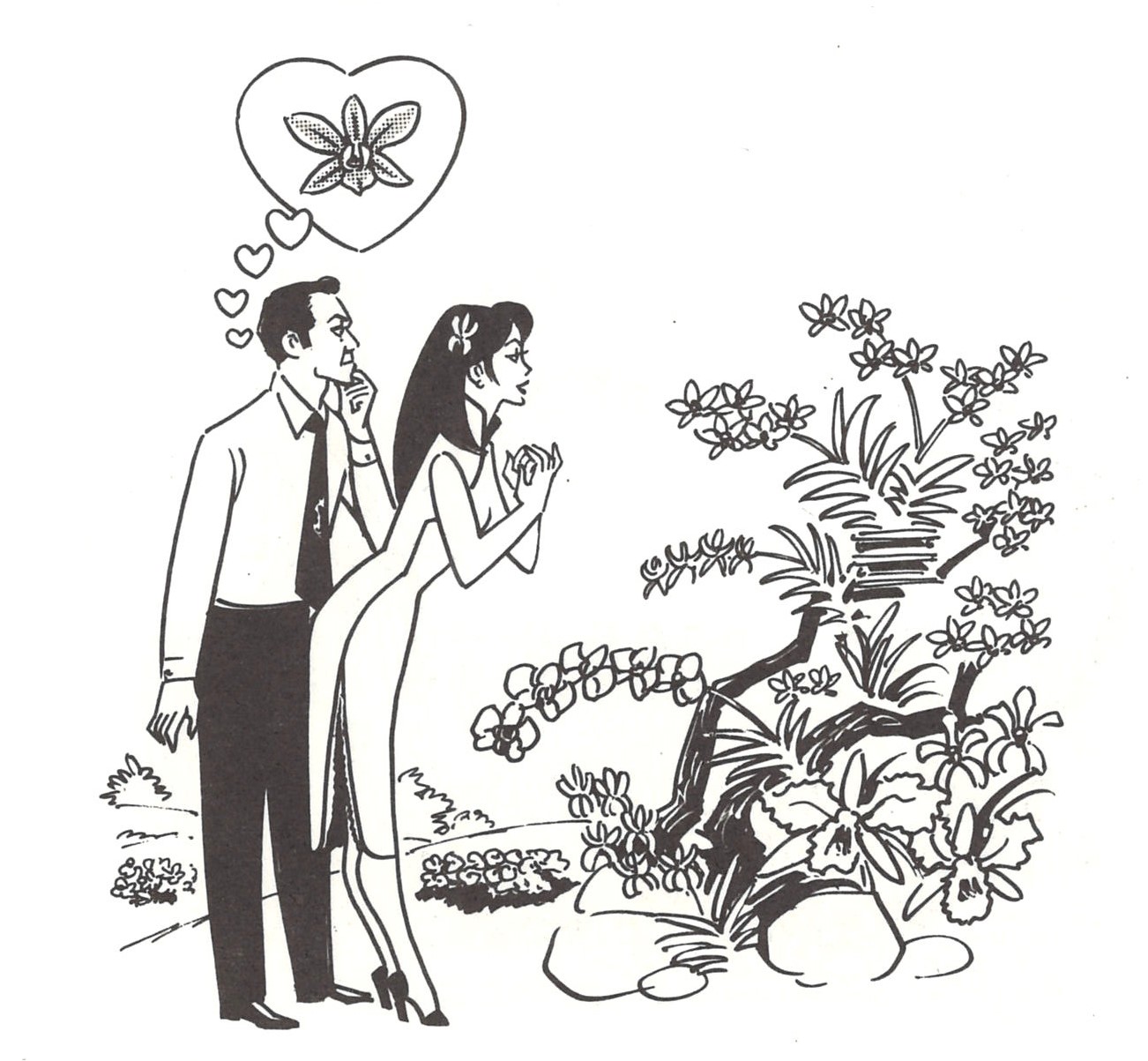 Illustration of how the wish of Lee Kum Tatt’s wife sparked the idea of the RISIS orchid. Image reproduced from The RISIS Orchid (Singapore: Times Books International, 1984), 22. (From National Library, Singapore, call no. RSING 739.27095957 JOF).
Illustration of how the wish of Lee Kum Tatt’s wife sparked the idea of the RISIS orchid. Image reproduced from The RISIS Orchid (Singapore: Times Books International, 1984), 22. (From National Library, Singapore, call no. RSING 739.27095957 JOF).Lee thought that gold-plated orchids were the perfect choice for a souvenir as Singapore was already known for its orchids, not only routinely presenting them to guests but also exporting large shipments of them. There was a thriving Singapore Orchid Society; and the President of the South East Asia Orchid Society was usually a Singaporean. Singapore was also a leader in orchid hybridisation. For all these reasons, Lee felt that “[t]he gold orchid had all the attributes of a true souvenir. It used local material (orchids) and local technology or skill (hybridisation and metal-forming), as well as time-honoured gold”.11
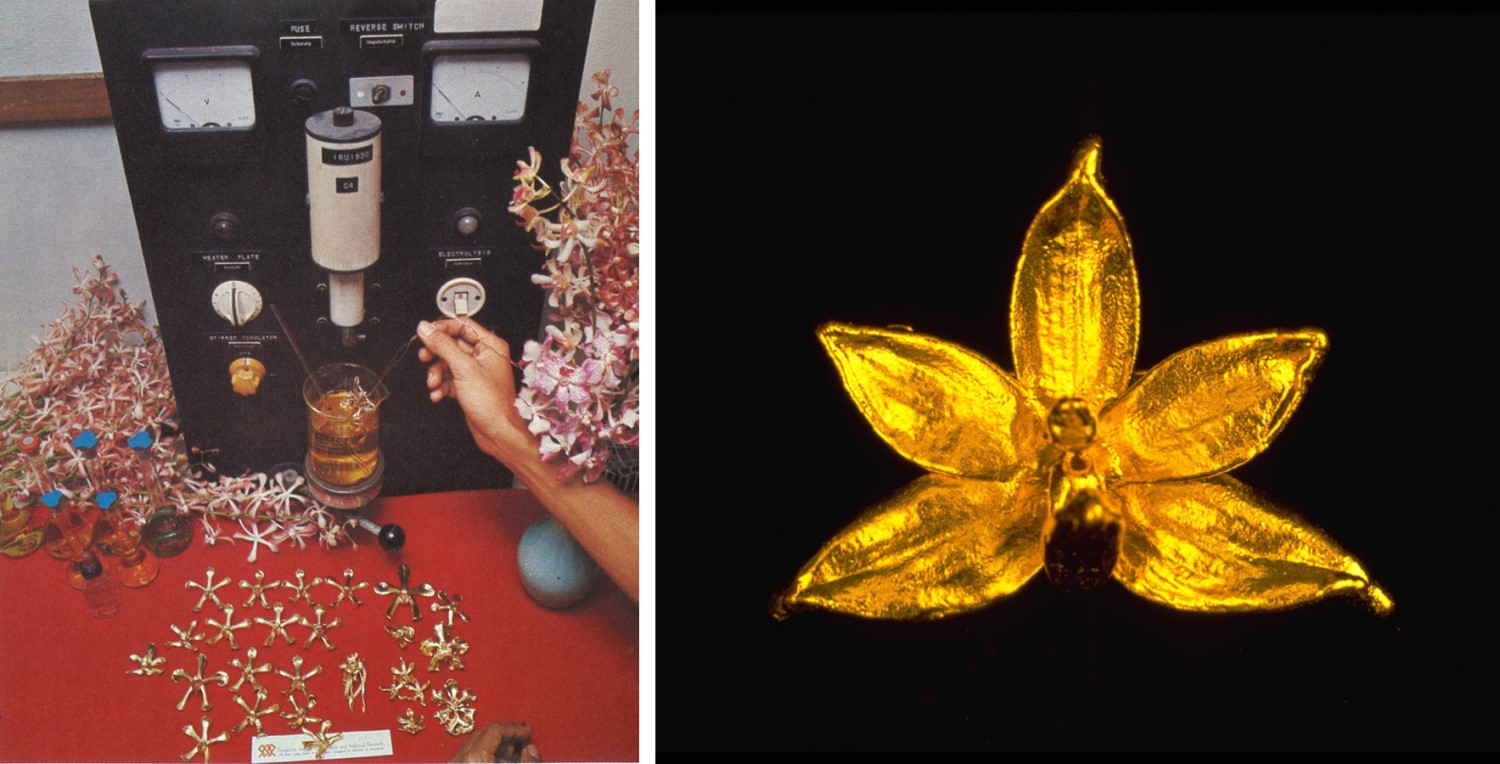 (Left) The process of gold-plating orchids developed at SISIR, 1975. Image reproduced from Singapore Institute of Standards and Industrial Research, SISIR Annual Report 1975/76 (Singapore: The Institute, 1975), 30. (From National Library, Singapore, call no. RSING 354.5957093 SISIRA)
(Left) The process of gold-plating orchids developed at SISIR, 1975. Image reproduced from Singapore Institute of Standards and Industrial Research, SISIR Annual Report 1975/76 (Singapore: The Institute, 1975), 30. (From National Library, Singapore, call no. RSING 354.5957093 SISIRA)(Right) A RISIS orchid, 1980. Singapore Tourist Promotion Board Collection, courtesy of National Archives of Singapore.
However, coming up with the idea was one thing, turning it into reality was another. “We were basically trying to create an instant Singapore souvenir in the same way we plant instant trees, or make instant coffee,” Lee explained. “It certainly did not look promising.”12 Trained as a chemist, Lee’s early experiments were conducted at home with makeshift plastic equipment. The need for more systematic research led him to use $25,000 from SISIR’s reserve fund for official investigation using its facilities. Fittingly, once perfected, Lee gave one of the first orchids to his wife.13 Another early creation was given to Singapore’s then First Lady Yeo Seh Geok (wife of President Benjamin Sheares) in 1975.14 The name for this gold-plated flower was simply a reversal of “SISIR” – the institution behind it – and thus RISIS was born.
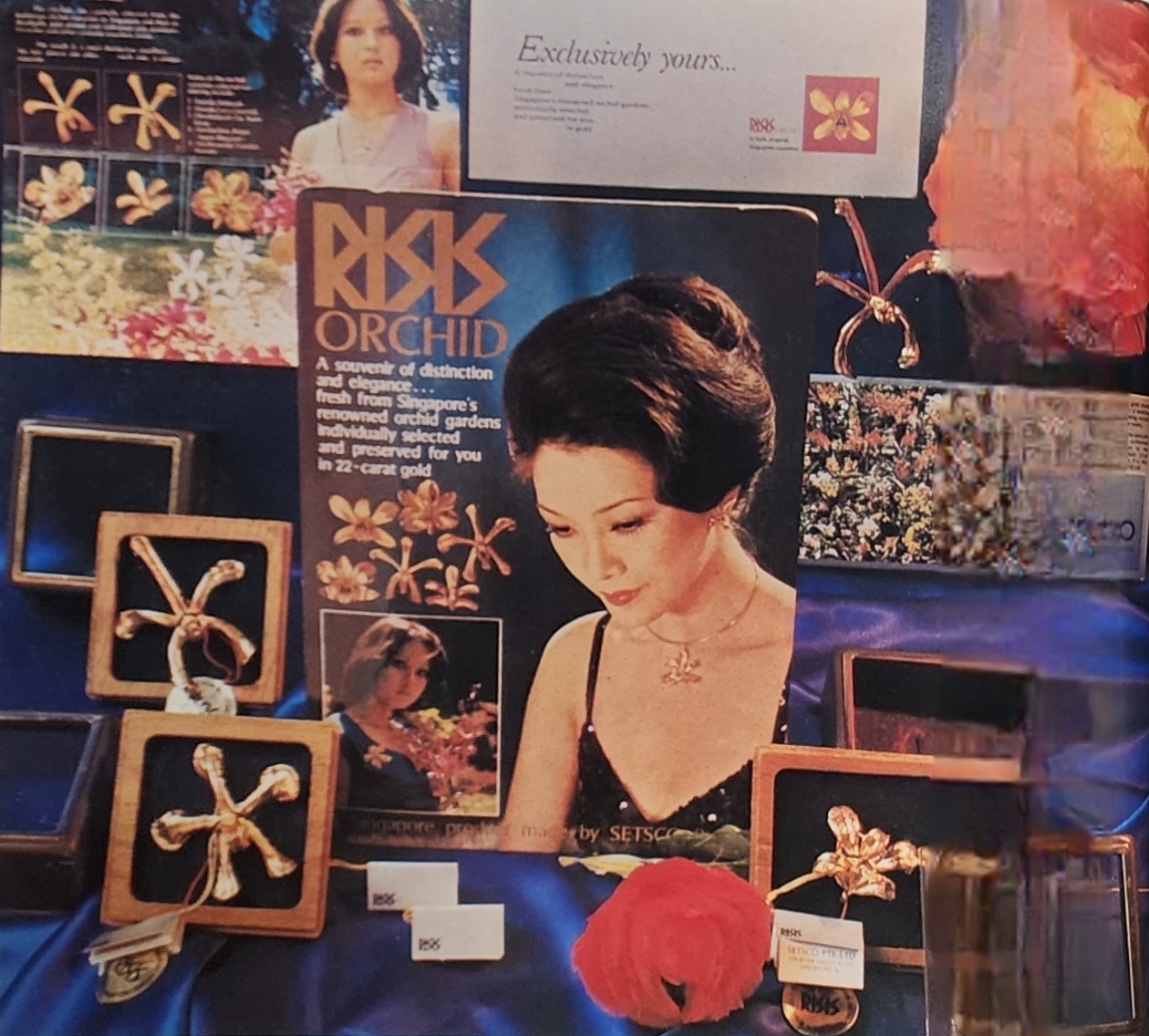 RISIS gold-plated orchids and publicity material on display. Image reproduced from Singapore Institute of Standards and Industrial Research, SISIR Annual Report 1975/76 (Singapore: The Institute, 1975), 21. (From National Library, Singapore, call no. RSING 354.5957093 SISIRA).
RISIS gold-plated orchids and publicity material on display. Image reproduced from Singapore Institute of Standards and Industrial Research, SISIR Annual Report 1975/76 (Singapore: The Institute, 1975), 21. (From National Library, Singapore, call no. RSING 354.5957093 SISIRA).Days before the official launch of RISIS in April 1976, SISIR created a subsidiary, Setsco Pte Ltd, to handle full-scale commercial production of the gold-plated flowers. Setsco subsequently created RISIS Pte Ltd, a subsidiary dedicated to handling its gold-plated products. The RISIS orchid was available at nearly 70 stores around the island when it was launched.15
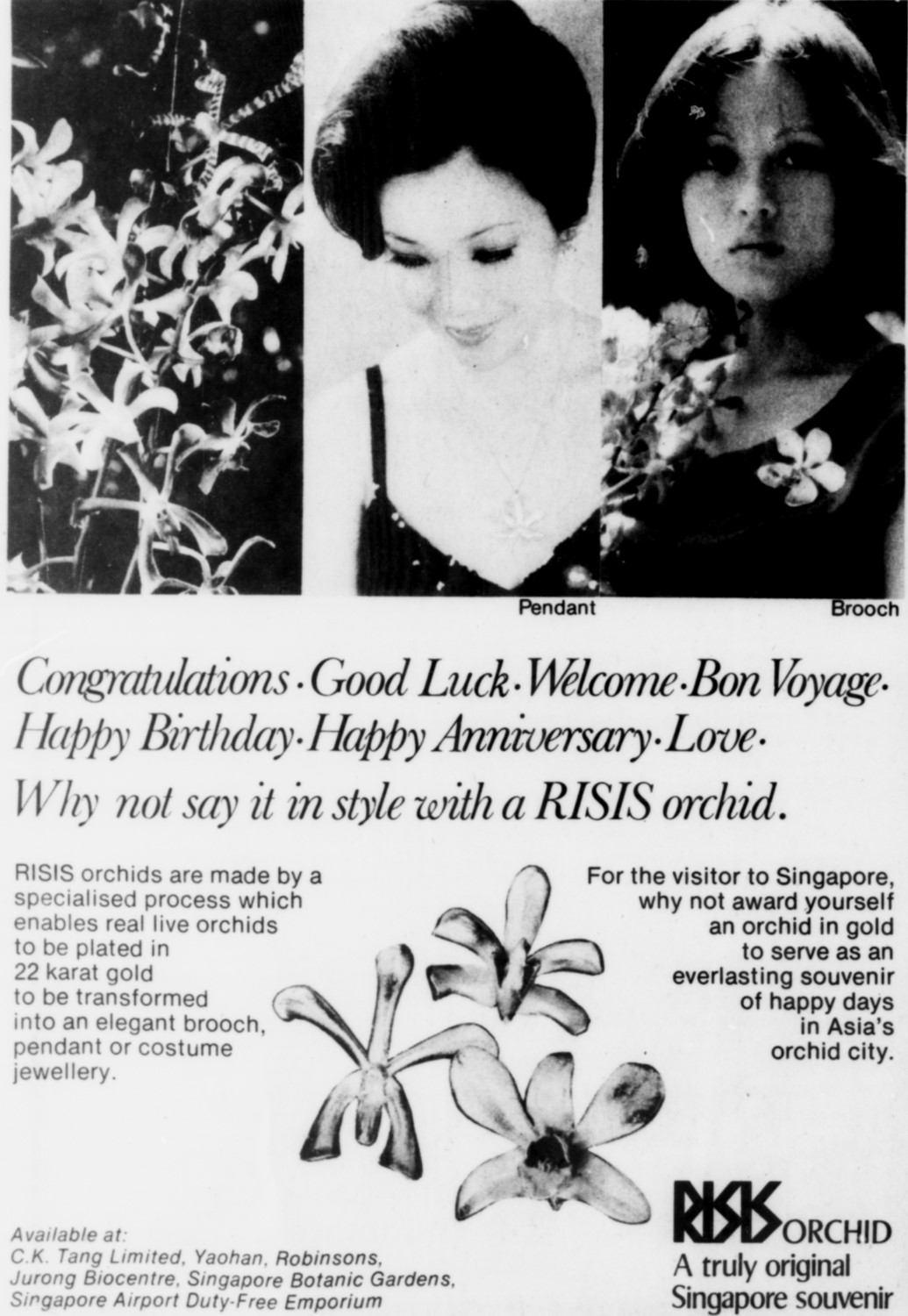 The RISIS orchid was marketed as a perfect gift for any occasion. Image reproduced from “Page 25 Advertisements Column 1,” Straits Times, 12 August 1976, 25. (From NewspaperSG).
The RISIS orchid was marketed as a perfect gift for any occasion. Image reproduced from “Page 25 Advertisements Column 1,” Straits Times, 12 August 1976, 25. (From NewspaperSG).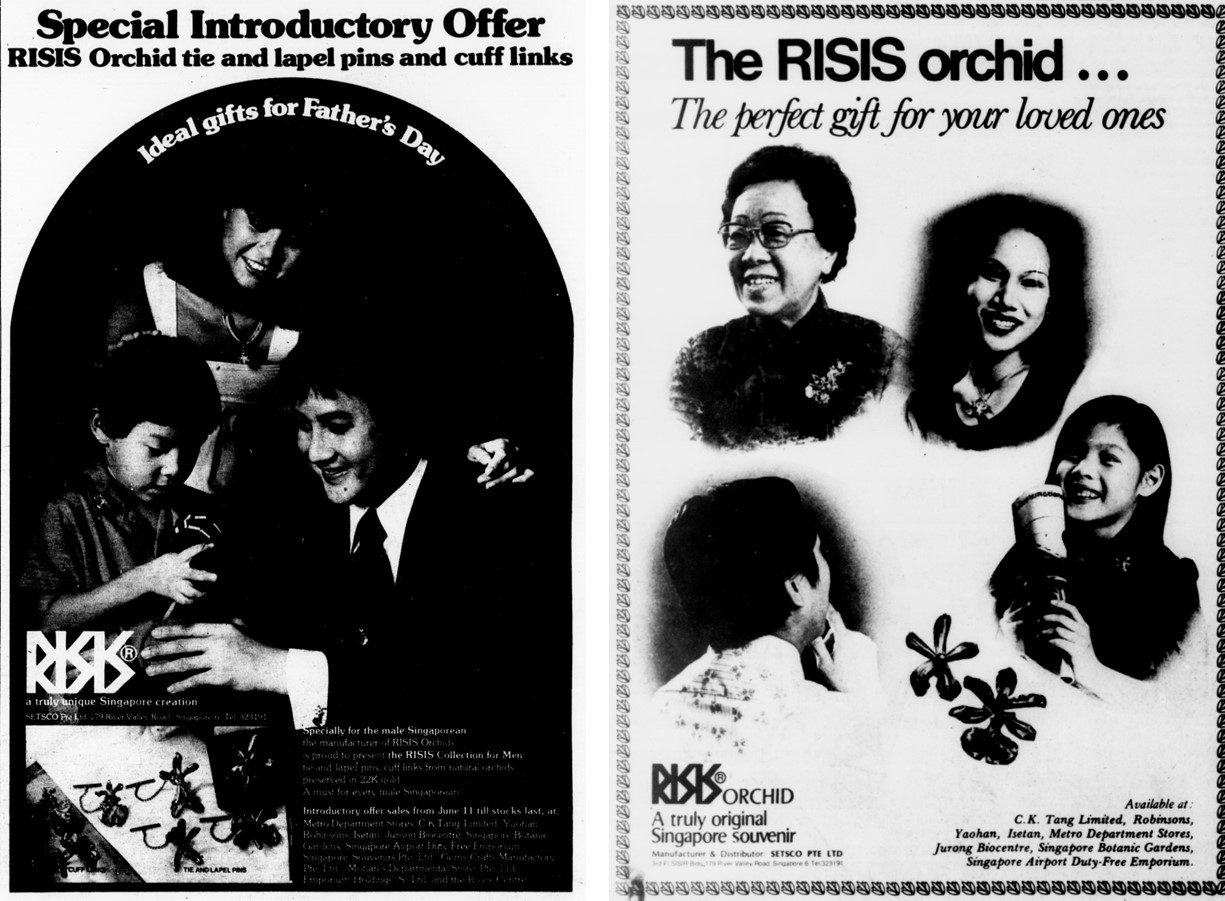 RISIS orchids were manufactured into tie and lapel pins and cufflinks for men (left) as well as jewellery for women (right). Images reproduced from “Page 5 Advertisements Column 1,” New Nation, 9 June 1977, 5. (From NewspaperSG) and “Page 8 Advertisements Column 1,” Straits Times, 13 November 1976. 8. (From NewspaperSG).
RISIS orchids were manufactured into tie and lapel pins and cufflinks for men (left) as well as jewellery for women (right). Images reproduced from “Page 5 Advertisements Column 1,” New Nation, 9 June 1977, 5. (From NewspaperSG) and “Page 8 Advertisements Column 1,” Straits Times, 13 November 1976. 8. (From NewspaperSG).The orchid was advertised in newspapers as a suitable gift for everyone and for every festive occasion.16 This strategy struck gold: all 3,000 orchids were sold out within days, despite each customer being limited to only one piece.17 On 3 May, Setsco published an advertisement apologising for their entire stock being sold out due to “overwhelming public response” – an apology which also conveniently doubled as great publicity.18 By the end of its first year, 100,000 RISIS orchids had been sold, accounting for nearly $2 million in sales.19
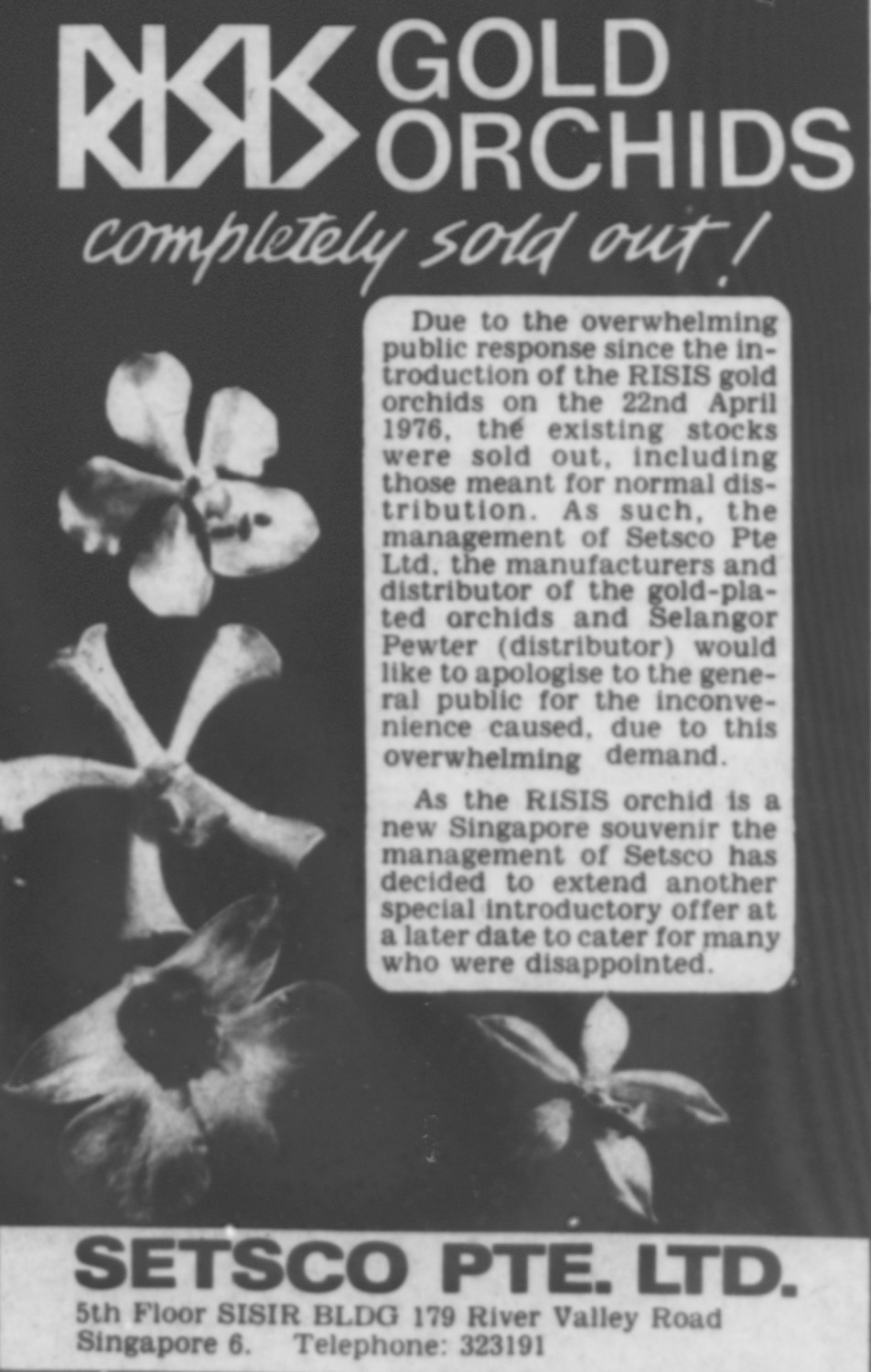 Setsco published an apology in the papers in 1976 for having run out of its orchids. Image reproduced from “Page 19 Advertisements Column 3,” Straits Times, 3 May 1976, 19. (From NewspaperSG).
Setsco published an apology in the papers in 1976 for having run out of its orchids. Image reproduced from “Page 19 Advertisements Column 3,” Straits Times, 3 May 1976, 19. (From NewspaperSG).RISIS wasn’t just popular locally – it also quickly won fans abroad. An exhibition at the Frankfurt Fair led to an immediate order worth $50,000.20 By early 1978, local sales had grown to 12,000 a month, while export orders totalling $500,000 had been received. To keep up with demand, Setsco’s plant capacity had to be expanded five different times and its number of employees ballooned from 24 to 180.21
Prominently associated with the Singapore brand, these golden orchids seemed to be everywhere in the 1970s and 1980s . At the 1977 Singapore Fair organised by the Singapore Manufacturers’ Association (SMA), the winner of the Miss SMA title was presented with a RISIS orchid, along with a trophy and an all-expenses paid trip to Copenhagen. The runner-up received a RISIS orchid and household appliances.22 The Business Times described the orchids as “the highlight of the London Impo-Expo 1979,” and a RISIS export agent accounted for this success by speculating that “they offer the mystique of the Orient in the shape of a flower”.23
When the Vanda Miss Joaquim was declared Singapore’s national flower in 1981, an article in New Nation even suggested the government give all baby girls named Joaquim that year an 18-carat gold RISIS-version of the Vanda Miss Joaquim orchid instead of milk powder.24 At the 1984 ASEAN Orchid Congress in Singapore, prize-winners received special commemorative trophies with “sprays of gold-plated RISIS orchids” mounted on a plate.25 When STPB started awarding “Tourism Awards” in 1985, RISIS won in the inaugural “Best Tourism Souvenir” category, which received 39 submissions.26
Perhaps the most vivid sign of how central RISIS had become to the Singaporean identity can be seen in its deployment for philosophical soul-searching. In her article “Look No Further for Our National Symbol” published in the Straits Times, Nancy Chng suggested that the RISIS orchid was a fitting choice precisely because “there is something artificial and uptight about it that remind[ed her] of the Singaporean character”. She was writing in 1980, after a decade of public concern over the supposed coarsening moral character of Singaporeans.27 “It is valued more for the gold-plating than the beauty of the flower within,” she lamented, “in much the same way that the single-minded pursuit of success, material success, has caused Singaporeans to suppress their genteel or gentler nature.”28
Golden Orchid Diplomacy
Orchids have been an important diplomatic tool for Singapore since the mid-20th century. “Orchid diplomacy” saw prominent foreign visitors – heads of state, heads of government, celebrities – treated to an orchid from the Singapore Botanic Gardens named after them.29 With the creation of RISIS, it also became customary to give these VIPs a gold-plated version of their namesake orchid.30
 An illustration showcasing the large number of orchids named after celebrities, 1984. Image reproduced from The RISIS Orchid (Singapore: Times Books International, 1984), 21. (From National Library, Singapore, call no. RSING 739.27095957 JOF).
An illustration showcasing the large number of orchids named after celebrities, 1984. Image reproduced from The RISIS Orchid (Singapore: Times Books International, 1984), 21. (From National Library, Singapore, call no. RSING 739.27095957 JOF).During Queen Elizabeth’s inaugural visit to Singapore in February 1972, she chose a yellow Dendrobium at the Singapore Botanic Gardens to be named after her.31 In May 1984, 12 years later, she was presented with “a spray of orchids preserved in gold” during the International Garden Festival in Liverpool. The orchid presented was, of course, the Elizabeth Dendrobium.32
In 1990, the royal consort of the Sultan of Brunei, Raja Isteri Pengiran Anak Saleha, was not just gifted a gold-plated Dendrobium Saleha, she was also told that if she wanted other gold-plated souvenirs for her friends, RISIS could have them made for her.33
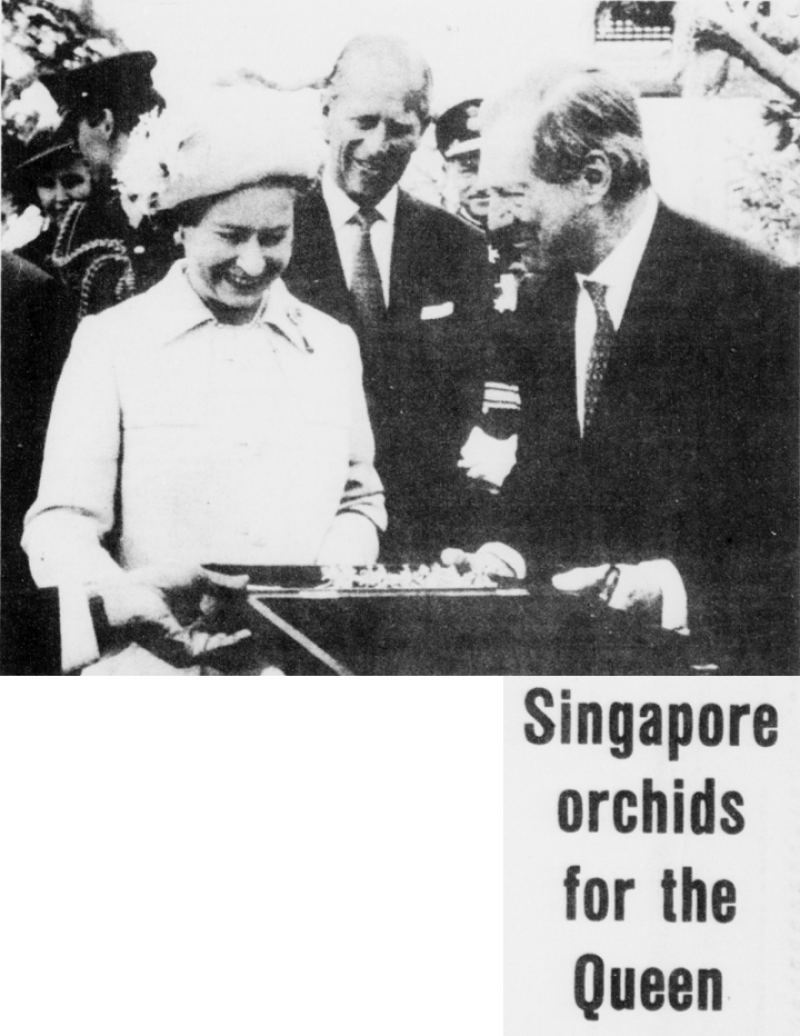 Lord Aberconway, Britain’s Commissioner-General, presenting Queen Elizabeth with her namesake RISIS gold-plated orchids at the International Garden Festival in Liverpool in 1984. Source: The Straits Times, 5 May 1984 © SPH Media Limited. Permission required for reproduction.
Lord Aberconway, Britain’s Commissioner-General, presenting Queen Elizabeth with her namesake RISIS gold-plated orchids at the International Garden Festival in Liverpool in 1984. Source: The Straits Times, 5 May 1984 © SPH Media Limited. Permission required for reproduction.Just as deploying the RISIS orchids enhanced Singapore’s standing, the association of the orchid with celebrities enhanced the stature of RISIS. In sending Princess Diana a RISIS brooch in December 1982, the Singapore Monitor noted that “Princess Diana, whose hairstyle and taste in clothes are widely copied, may just give the RISIS orchid the boost it needs to become internationally fashionable”.34 Indeed, RISIS soon launched a top-of-the-line Royal RISIS collection whose prices started at $500. The collection made its debut in a 1986 Fashion Show at the York Hotel, which featured clothes by Bruce Oldfield, who was advertised as “Princess Diana’s designer”.35
Orchids were also used to promote tourism. When Singapore received its two millionth tourist in December 1978, the country went all-out to mark the event. The lucky visitor was Iris Harris, an English Health Officer who had flown in from London. After clearing customs, Harris and her husband were whisked onto a stage decorated with RISIS orchids worth $40,000. They were then driven by limousine to the Presidential suite at the Singapore Hilton for their stay, received a $3,000 shopping voucher, and then treated to a $7,500 Emperor’s Banquet, comprising 48 courses at the Cockpit Hotel. Finally, an orchid was named after Harris and she was gifted a diamond-studded, gold-plated version of that same orchid.36
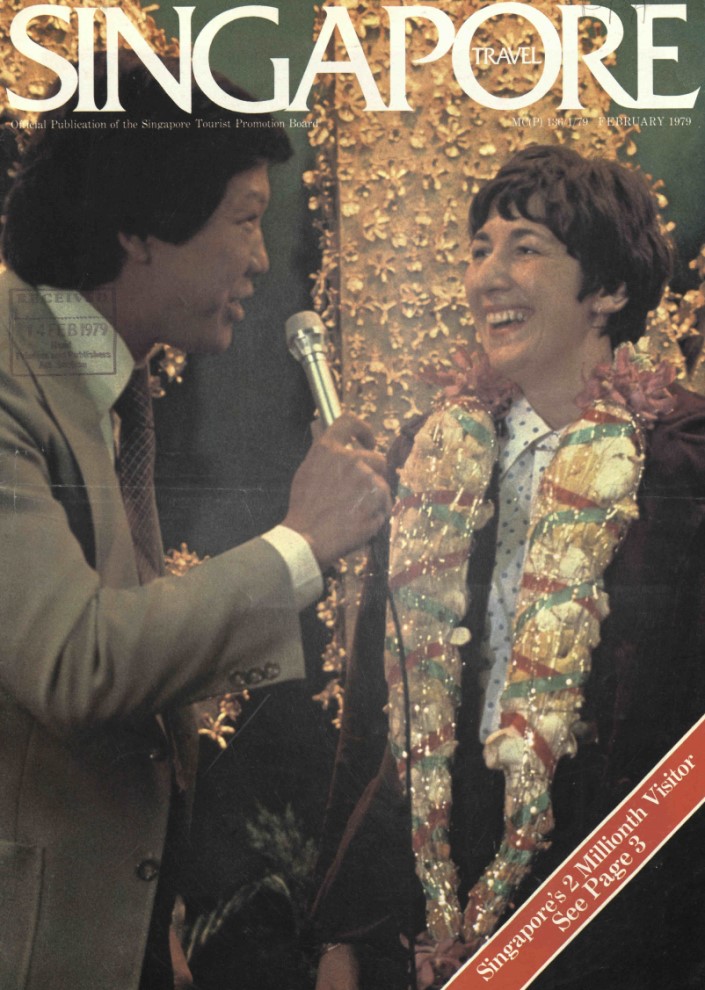 Singapore’s second-millionth tourist Iris Harris being interviewed in front of a stage decorated with $40,000 worth of RISIS flowers. Image reproduced from Singapore Travel: Official Publication of the Singapore Tourist Promotion Board, Feb 1979 (Singapore: Singapore National Printers, 1979). (From National Library Online).
Singapore’s second-millionth tourist Iris Harris being interviewed in front of a stage decorated with $40,000 worth of RISIS flowers. Image reproduced from Singapore Travel: Official Publication of the Singapore Tourist Promotion Board, Feb 1979 (Singapore: Singapore National Printers, 1979). (From National Library Online).Beyond Orchids
The success of the RISIS orchid inspired SISIR to gold-plate other items. The first addition was tropical leaves and ferns, which were chosen for the RISIS Floral Collection in July 1979.37 Following the success of the Floral Collection, SISIR designed pendants, bracelets and cufflinks which incorporated gold-plated coins.38
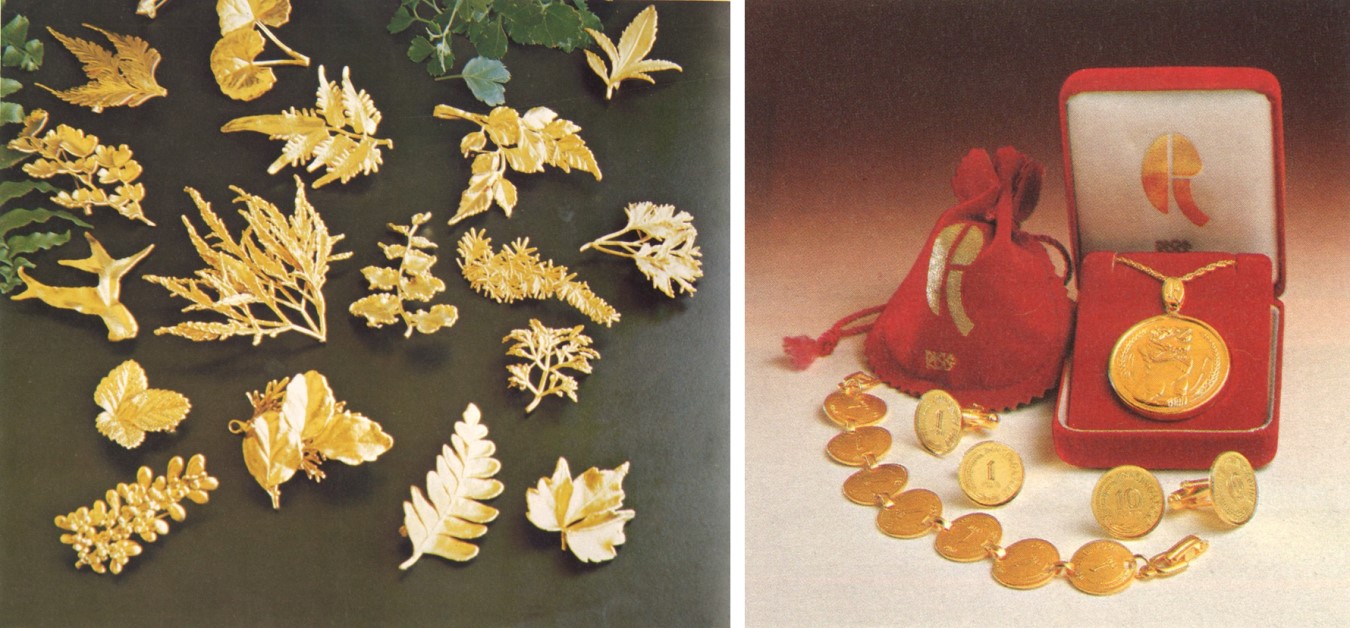 Gold-plated tropical leaves and ferns from the 1979 RISIS Floral Collection (left) and gold-plated coins (right). Images reproduced from Singapore Institute of Standards and Industrial Research, Annual Report of SISIR 1978/79 (Singapore, The Institute), 22. (From National Library, Singapore, call no. RSING 354.5957093 SISIRA) and Singapore Institute of Standards and Industrial Research, Annual Report of SISIR 1980/81 (Singapore, The Institute), 33. (From National Library, Singapore, call no. RSING 354.5957093 SISIRA).
Gold-plated tropical leaves and ferns from the 1979 RISIS Floral Collection (left) and gold-plated coins (right). Images reproduced from Singapore Institute of Standards and Industrial Research, Annual Report of SISIR 1978/79 (Singapore, The Institute), 22. (From National Library, Singapore, call no. RSING 354.5957093 SISIRA) and Singapore Institute of Standards and Industrial Research, Annual Report of SISIR 1980/81 (Singapore, The Institute), 33. (From National Library, Singapore, call no. RSING 354.5957093 SISIRA). Assortment of RISIS gold eggs. Ministry of Information and the Arts Collection, courtesy of National Archives of Singapore.
Assortment of RISIS gold eggs. Ministry of Information and the Arts Collection, courtesy of National Archives of Singapore.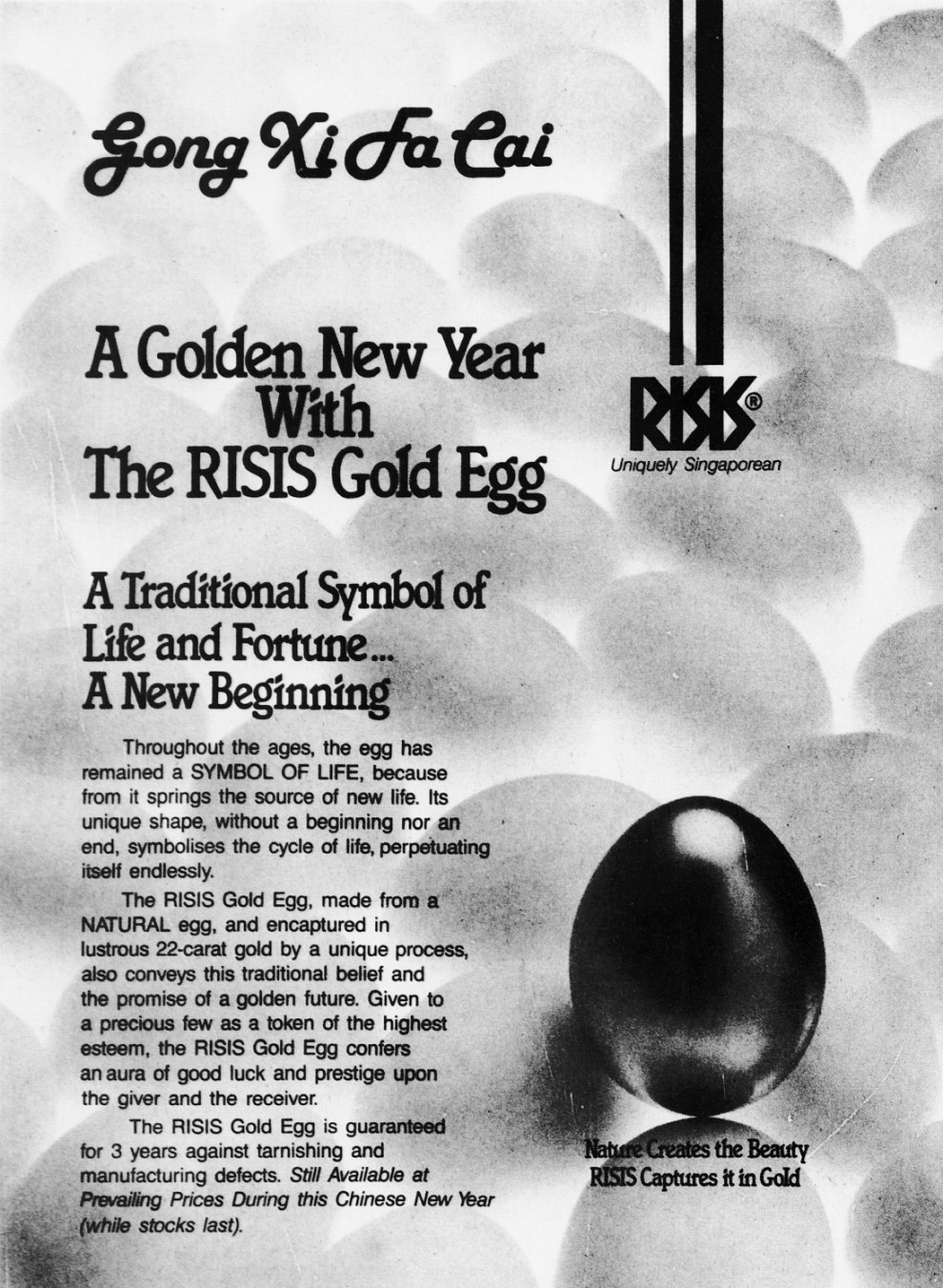 Advertisement promoting RISIS’s gold egg in 1984. Image reproduced from “Page 40 Advertisements Column 1,” Straits Times, 28 January 1984, 40. (From NewspaperSG)
Advertisement promoting RISIS’s gold egg in 1984. Image reproduced from “Page 40 Advertisements Column 1,” Straits Times, 28 January 1984, 40. (From NewspaperSG)In 1984, RISIS launched gold-plated eggs for Chinese New Year. Positioning the egg as a symbol of life, advertisements suggested that the egg would “confer an aura of good luck and prestige upon the giver and the receiver”.39
These eggs soon became an addition to the ongoing diplomatic practice of gifting gold-plated orchids – visiting dignitaries were now gifted commemorative eggs too. For example, in 1983, Tsutako Nakasone, the Japanese Prime Minister’s wife, was given a tour of Setsco’s facility at River Valley Road and presented with a 22-carat gold-plated goose egg at the end of the tour. The next day she visited the Singapore Botanic Gardens, where she was given a golden orchid.40 Just as the orchids came from local nurseries, local farms supplied Setsco with goose, quail and chicken eggs.41
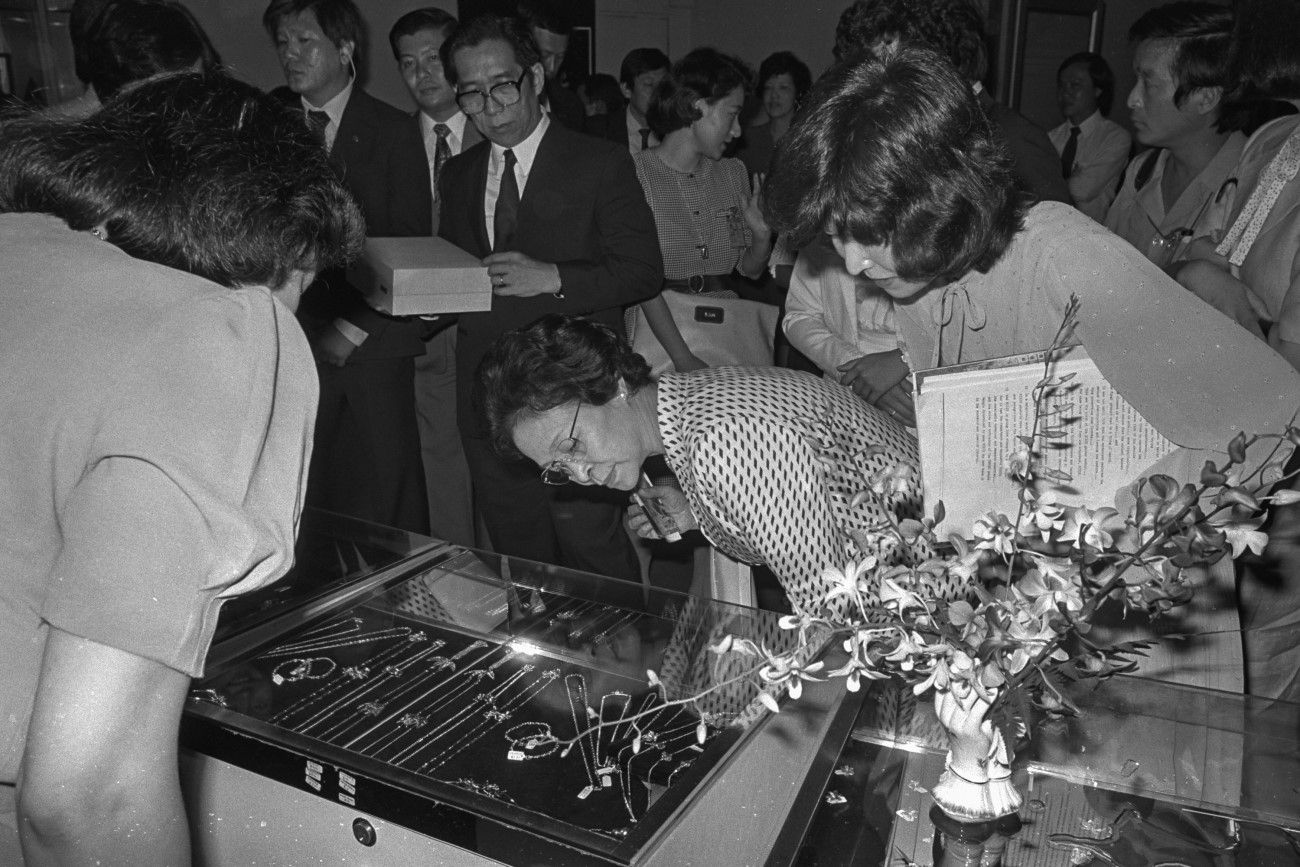 Tsutako Nakasone (with glasses), wife of Japanese Prime Minister Yasuhiro Nakasone, observes RISIS’ creations at the Setsco facility in 1983. Ministry of Information and the Arts Collection, courtesy of National Archives of Singapore.
Tsutako Nakasone (with glasses), wife of Japanese Prime Minister Yasuhiro Nakasone, observes RISIS’ creations at the Setsco facility in 1983. Ministry of Information and the Arts Collection, courtesy of National Archives of Singapore.Imitation might be the highest form of flattery, but in the commercial world, it is also illegal. Forgeries of RISIS products did not just reduce sales, they also threatened its reputation. In 1985, for example, a curious Japanese tourist hammered open a gold-plated egg he bought, only to find a rotten raw egg inside. Furious at having shelled out more than a hundred dollars for his eggs, he marched to Setsco to complain.
Fortunately for Setsco (but unfortunately for the Japanese tourist), he had bought imitation eggs. Genuine RISIS eggs were always emptied before being gold-plated. In fact, Lee had complained that when they started making these eggs, he “had to eat omelette for the next 20 days”.42
In response to the fake eggs scandal, Setsco sent warning letters to 10 stores known to be selling them.43 Setsco also urged the public to be vigilant and ensure the authenticity of their RISIS eggs by making sure “RISIS” was inscribed on base of the eggs. In addition, they could carry out a little test – real RISIS eggs could supposedly balance upright on their own, while fakes just rolled over.44
The Gold Menagerie
In 1986, as part of the government’s larger privatisation thrust, Setco sold its subsidiary RISIS Pte Ltd to private companies.45 Lee, however, remained Director and Consultant to RISIS until 1990.46
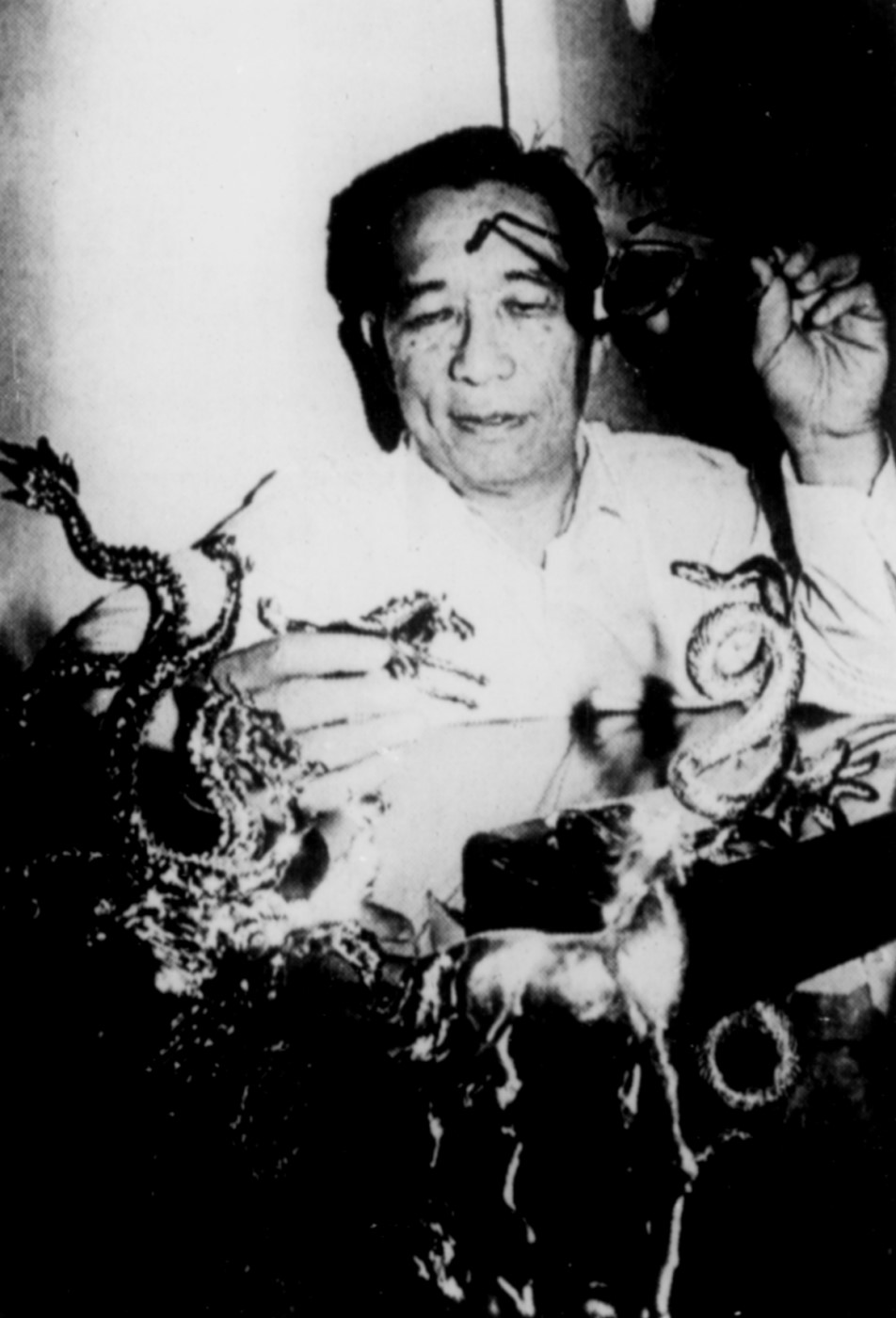 Dr Lee Kum Tatt with some of his creations, 1989. Source: The Straits Times, 26 May 1989 © SPH Media Limited. Permission required for reproduction.
Dr Lee Kum Tatt with some of his creations, 1989. Source: The Straits Times, 26 May 1989 © SPH Media Limited. Permission required for reproduction.From the mid-80s, RISIS started emphasising Chinese culture in both the items sold and the narratives deployed. These included walnuts47 and gold-plated figurines celebrating the year’s Chinese Zodiac animal (of course, without live animal encased within). For the Year of the Snake in 1989, RISIS released a gold-plated snake curled to resemble the Chinese character for patience, its advertisement announcing “Virtue Captured in Gold”.48 This trend reached its zenith in 1990, the year of the Golden Horse. Golden horses inspired by the paintings of renowned Chinese artist Xu Beihong were sold by RISIS, this time with the declaration that horses, not dogs, were Man’s best friend.49
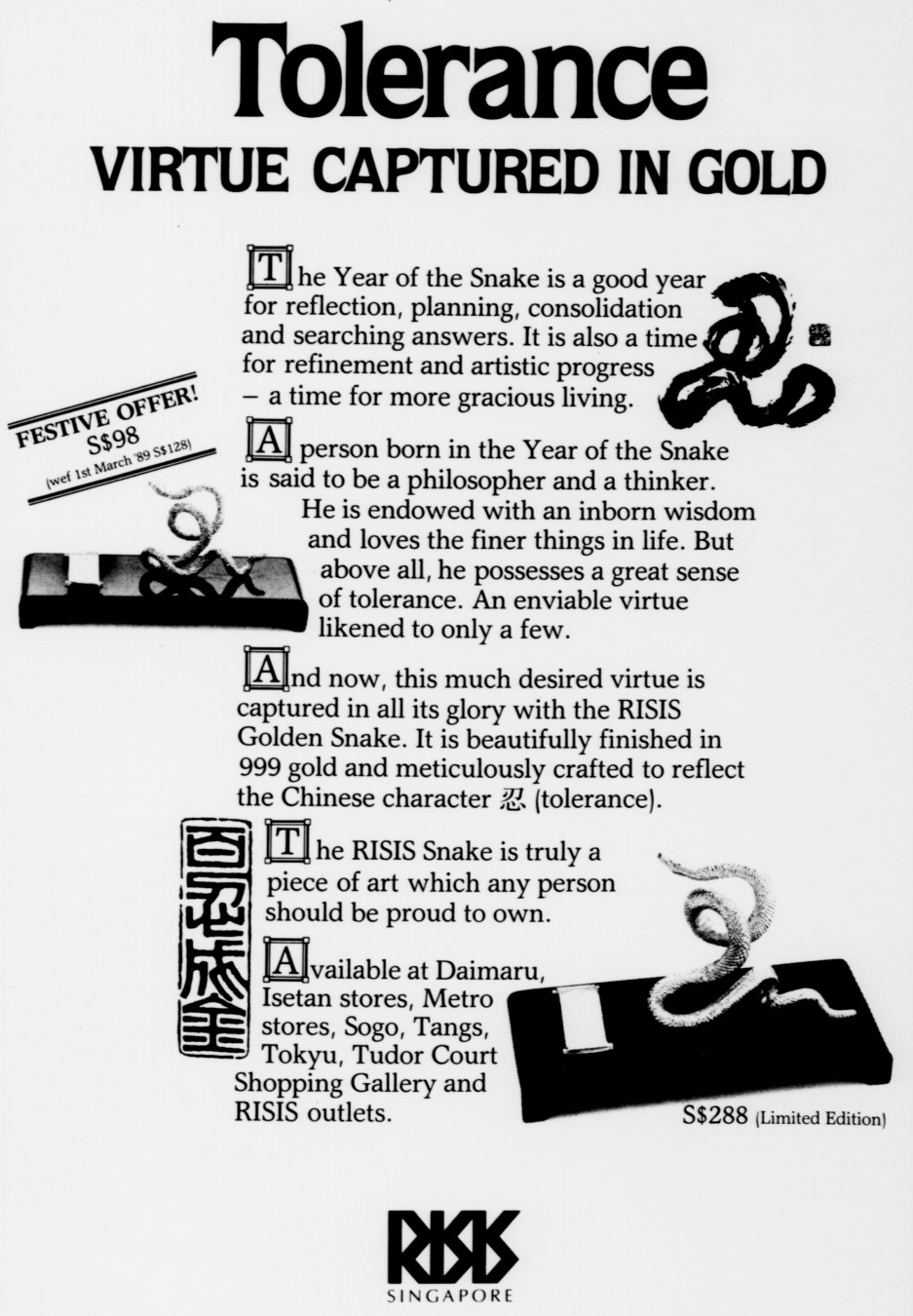 Advertisement for the 1989 snake. Image reproduced from “Page 5 Advertisements Column 1,” Business Times, 30 December 1988, 5. (From NewspaperSG).
Advertisement for the 1989 snake. Image reproduced from “Page 5 Advertisements Column 1,” Business Times, 30 December 1988, 5. (From NewspaperSG).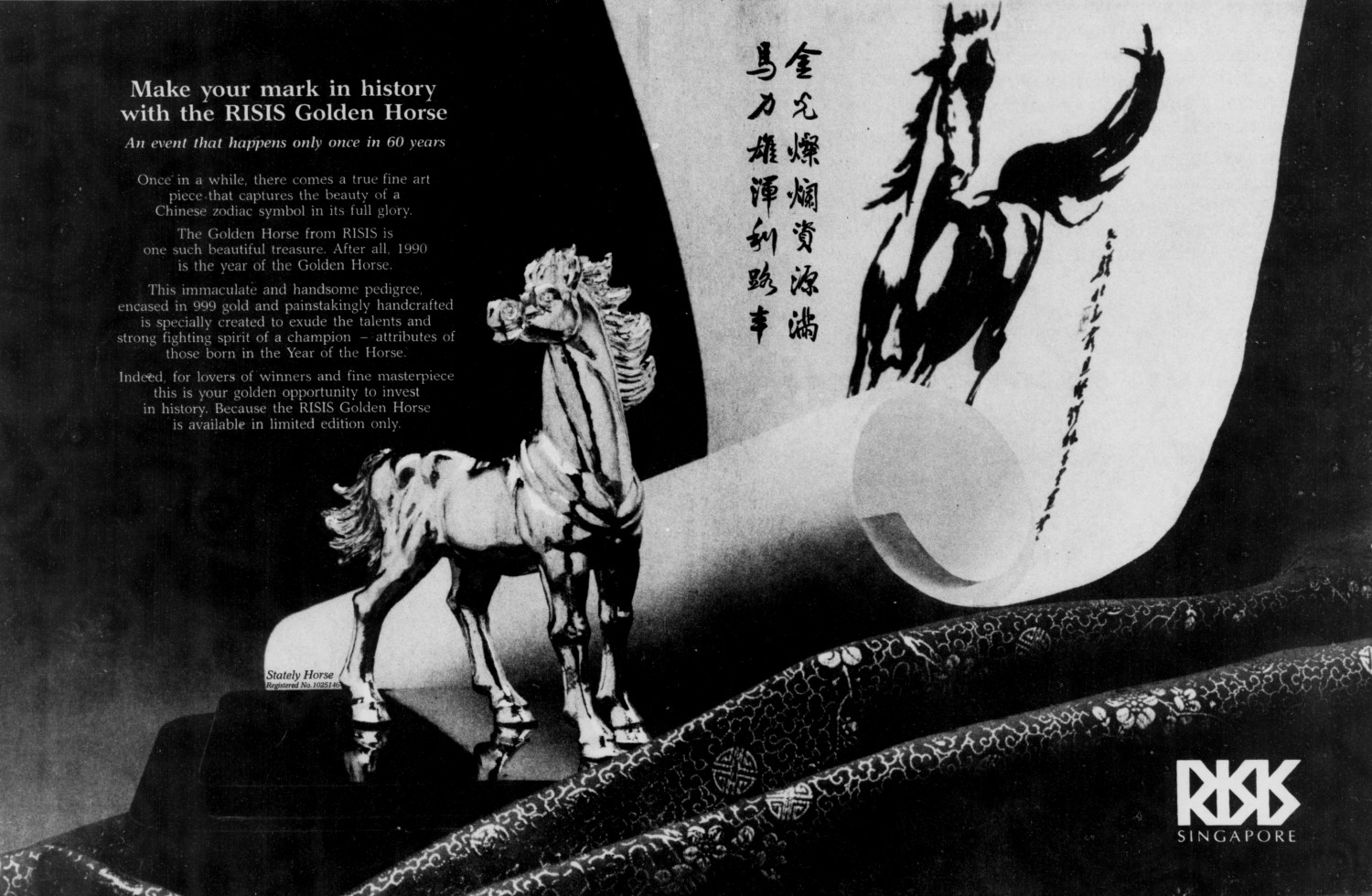 The RISIS golden horse was inspired by renowned Chinese artist Xu Beihong. Image reproduced from “Page 3 Advertisements Column 1,” Straits Times, 9 December 1989, 3. (From NewspaperSG).
The RISIS golden horse was inspired by renowned Chinese artist Xu Beihong. Image reproduced from “Page 3 Advertisements Column 1,” Straits Times, 9 December 1989, 3. (From NewspaperSG).Lee’s final animal was a gold-plated origami paper crane, which was inspired by a paper crane folding initiative by the residents of Bukit Gombak (he was chairman of the Bukit Gombak Citizen’s Consultative Committee) and his granddaughter (who had wanted a paper crane that would last). It was made of pewter and then plated with gold. With a $97,000 grant from the Trade Development Board (TDB; now IE Singapore), he created six versions of these (after his retirement in 1990), which then went on sale at TDB’s Design Centre in 1993.50
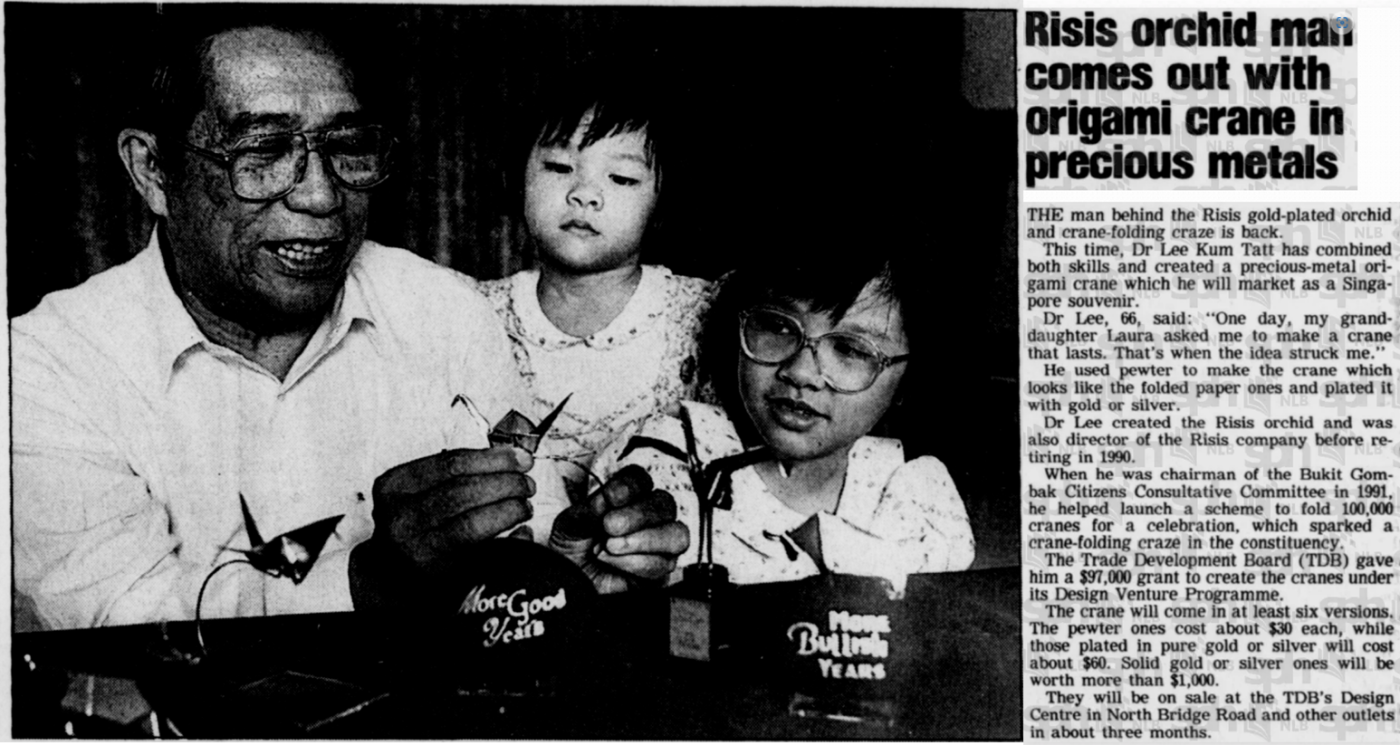 Lee with his granddaughters. The idea for the metal origami crane came to him when his granddaughter asked him for a crane that would last. Source: The Straits Times, 28 February 1993 © SPH Media Limited. Permission required for reproduction.
Lee with his granddaughters. The idea for the metal origami crane came to him when his granddaughter asked him for a crane that would last. Source: The Straits Times, 28 February 1993 © SPH Media Limited. Permission required for reproduction.While RISIS continues to sell its signature gold-plated items today, it has extended its product line to include other items like chopsticks (with gold-plated tips) and penholders (with mounted golden flowers). Its gold animals of the Chinese zodiac also remain for sale: a resin dragon with 24K gold-plating that stands at 29 cm and weighs 5.5 kg retails for $7,388. Its gold-plated eggs are still available and have grown even larger – according to its website, a 24K gold-plated ostrich egg weighing 5 kg goes for $1,988.51 The national prominence of RISIS might have waned but RISIS and its products remind us of the aspirations of the once newly industrialising Singapore and how far we have come since then.
 Sharad Pandian graduated from Nanyang Technological University with a degree in physics before pursuing a Master of Philosophy in history and philosophy of science at the University of Cambridge as a Gates-Cambridge Scholar. Sharad is interested in the history of science and standardisation in Asia. He is a former Lee Kong Chian Research Fellow with the National Library, Singapore (2022–23).
Sharad Pandian graduated from Nanyang Technological University with a degree in physics before pursuing a Master of Philosophy in history and philosophy of science at the University of Cambridge as a Gates-Cambridge Scholar. Sharad is interested in the history of science and standardisation in Asia. He is a former Lee Kong Chian Research Fellow with the National Library, Singapore (2022–23).Notes
-
Stephen Guo, “Risis Orchid for Princess Diana,” Singapore Monitor, 8 December 1982, 8. (From NewspaperSG) ↩
-
Parliament of Singapore, Tourist Promotion Board Bill, 20 December 1963, vol. 22, cols. 1086–87, https://sprs.parl.gov.sg/search/#/topic?reportid=009_19631220_S0002_T0008. ↩
-
Singapore Tourist Promotion Board, Annual Report 1964 (Singapore: The Board, 1964), 1–2. (From National Library, Singapore, call no. RSING 338.479104 STPB) ↩
-
“Big Boost for Tourism as Govt Steps in,” Straits Times, 20 May 1964, 12. (From NewspaperSG) ↩
-
Singapore Economic Development Board, Annual Report 1970 (Singapore: Malaya Pub. House, 1970), 3–5. (From National Library, Singapore, call no. RSING 338.95957 SIN) ↩
-
Singapore Tourism Seminar, Proceedings of Singapore Tourism Seminar, 12–14 October 1970 (Singapore: Singapore Tourist Promotion Board, 1971), 70 (From National Library, Singapore, call no. RSING 338.47915957); “What We are Missing in the Souvenirs for the Tourists,” Straits Times, 15 October 1970, 11. (From NewspaperSG) ↩
-
Singapore Tourism Seminar, Proceedings, 75. ↩
-
Lawrence Basapa, “Singapore’s ‘Image Souvenir’ Is Yet to be Carved, But the Makers Are Ready,” Straits Times, 26 October 1970, 12. (From NewspaperSG) ↩
-
“Singapore’s ‘Image Souvenir’ Is Yet to be Carved, But the Makers Are Ready.” ↩
-
Yang Mei Ling, “Dr Lee Is a Many-talented ‘Radical’,” Straits Times, 26 May 1989, 29; Heidi Yeo, “Chemistry, Orchids, and Canada Did the Trick,” Straits Times, 1 April 1994, 10. (From NewspaperSG) ↩
-
Lee Kum Tatt, A Fabulous Journey (Singapore: The Word Press, 2012), 155–57. (From PublicationSG) ↩
-
Lee, A Fabulous Journey, 155. ↩
-
“Risis Orchid Creator Dies of Heart Attack,” Straits Times, 7 June 2008, 72. (From NewspaperSG) ↩
-
Lee, A Fabulous Journey, 157–58. ↩
-
“S’pore Orchids Don the ‘Golden’ Look,” Straits Times, 20 April 1976, 12. (From NewspaperSG) ↩
-
“Page 25 Advertisements Column 1,” Straits Times, 12 August 1976, 25. (From NewspaperSG) ↩
-
Lee, A Fabulous Journey, 158. ↩
-
“Page 19 Advertisements Column 3: RISIS Gold Orchids,” Straits Times, 3 May 1976, 19. (From NewspaperSG) ↩
-
Lee, A Fabulous Journey, 159. ↩
-
“S’pore Orchids Don the ‘Golden’ Look”; “Tempah $50,000 dari Jerman Untuk Orkid Emas,” Berita Harian, 21 April 1976, 8. (From NewspaperSG) ↩
-
“Risis Orchids Worth Their Weight in Gold,” Business Times, 16 February 1978, 2. (From NewspaperSG) ↩
-
“Fashion and Food Week Highlights,” Straits Times, 23 September 1977, 34. (From NewspaperSG) ↩
-
“Orchids Steal the Limelight,” Business Times, 4 August 1979, 2. (From NewspaperSG) ↩
-
Terry Tan, “Lovely Lady Miss Joaquim, Long May She Bloom,” New Nation, 19 April 1981, 8. (From NewspaperSG) ↩
-
“A Riotous Display of Blooms and Colour,” Straits Times, 29 July 1984, 10. (From NewspaperSG) ↩
-
“Tourism Awards Competition Draws 83 Entries,” Business Times, 13 November 1985, 3; “Awards for Boosting Tourism,” Business Times, 5 December 1985, 2. (From NewspaperSG) ↩
-
Lawrence Basapa, “Will the ‘Ugly Singaporean’ Ever Change His Attitude?” Straits Times, 17 May 1970, 10; Gloria Chandy, “Save the Kids from Turning into Brats,” New Nation, 26 February 1978, 7. (From NewspaperSG) ↩
-
Nancy Chng, “Look No Further for Our National Symbol,” Straits Times, 9 August 1980, 8. (From NewspaperSG) ↩
-
Rebecca Tan, “Flower Power: Singapore’s Orchid Diplomacy,” BiblioAsia, 18, no. 1 (April–June 2022); Ang Seow Leng, “More than Just a Flower: The Orchid’s Manifold Faces,” BiblioAsia, 7, no. 3 (October–December 2011). ↩
-
E Jofel, The RISIS Orchid (Singapore: Times Books International, 1984), 21. (From National Library, Singapore, call no. RSING 739.27095957 JOF) ↩
-
P.M. Raman, “Big Welcome for Queen Elizabeth,” Straits Times, 18 February 1972, 25; “A Saffron Spray Gets the Royal Vote,” Straits Times, 21 February 1972, 5. (From NewspaperSG) ↩
-
Teresa Ooi, “Orchids in Gold for the Queen,” Straits Times, 14 April 1984, 14; Singapore Orchid Display Wins Top Awards in Britain,” Straits Times, 26 May 1984, 49. (From NewspaperSG) ↩
-
“Raya Isteri Visits Risis Factory and Zoo,” Straits Times, 15 February 1990, 16. (From NewspaperSG) ↩
-
Guo, “Risis Orchid for Princess Diana.” ↩
-
“Risis Sparkles With a Jewelled Collection,” Business Times, 16 May 1986, 3. (From NewspaperSG) ↩
-
Singapore Institute of Standards and Industrial Research, Annual Report 1978/79 (Singapore: The Institute), 7. (From National Library, Singapore, call no. RSING 354.5957093 SISIRA-[AR]); “The 2 Millionth Visitor,” Straits Times, 23 December 1978, 1; “S’pore Crosses the Two Millionth Visitor Mark,” Straits Times, 23 December 1978, 9; “She Dines Like an Empress,” New Nation, 24 December 1978, 2. (From NewspaperSG) ↩
-
Singapore Institute of Standards and Industrial Research, Annual Report 1979/80 (Singapore: The Institute), 38. (From National Library, Singapore, call no. RSING 354.5957093 SISIRA-[AR]) ↩
-
Singapore Institute of Standards and Industrial Research, Annual Report 1980/81 (Singapore: The Institute), 33. (From National Library, Singapore, call no. RSING 354.5957093 SISIRA-[AR]) ↩
-
“Page 40 Advertisements Column 1,” Straits Times, 28 January 1984, 40. (From NewspaperSG) ↩
-
“Touch of Gold,” Straits Times, 5 May 1983, 40. (From NewspaperSG) ↩
-
Lisa Lee, “Risis Seeks To Transfer Its ‘Midas Touch’,” Business Times, 25 September 1986, 1. (From NewspaperSG) ↩
-
Gillian Pow Chong, “When a Golden Egg Stinks,” Straits Times, 20 January 1985, 1. (From NewspaperSG) ↩
-
“How to Tell If That Golden Egg Is Real,” Straits Times, 23 January 1985, 9. (From NewspaperSG) ↩
-
Singapore Institute of Standards and Industrial Research, Annual Report 1985/86 (Singapore: The Institute), 5. (From National Library, Singapore, call no. RSING 354.5957093 SISIRA-[AR]); Hsung Bee Hwa, “Risis Now Owned by Two Private Firms,” Straits Times, 4 November 1986, 22. (From NewspaperSG) ↩
-
Lee, A Fabulous Journey, 95; “The Risis Golden Horse Is Crafted as a Tribute to Civilisation,” Straits Times, 14 January 1990, 56. (From NewspaperSG) ↩
-
“Cash Carriers and Stress Relievers,” Business Times, 12 December 1985, 28; “Page 7 Advertisements Column 1,” Straits Times, 8 November 1985, 7. (From NewspaperSG) ↩
-
“Page 5 Advertisements Column 1,” Business Times, 30 December 1988, 5. (From NewspaperSG) ↩
-
“Page 3 Advertisements Column 1,” Straits Times, 9 December 1989, 3. (From NewspaperSG) ↩
-
“Risis Orchid Man Comes Out with Origami Crane in Precious Metals,” Straits Times, 28 February 1993, 22. (From NewspaperSG) ↩
-
“Home & Lifestyle,” RISIS, accessed 14 June 2024, https://risis.com/collections/home-lifestyle. ↩

